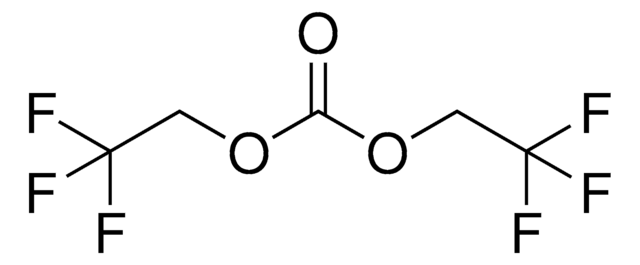287571
Bis(2,2,2-trifluoroethyl) ether
98%
Synonym(s):
2,2,2-Trifluoroethyl ether, Flurothyl
Sign Into View Organizational & Contract Pricing
All Photos(1)
About This Item
Linear Formula:
(CF3CH2)2O
CAS Number:
Molecular Weight:
182.06
Beilstein:
1811927
MDL number:
UNSPSC Code:
12352100
PubChem Substance ID:
NACRES:
NA.22
Recommended Products
Quality Level
Assay
98%
form
liquid
refractive index
n20/D 1.300 (lit.)
bp
62-63 °C (lit.)
density
1.404 g/mL at 25 °C (lit.)
functional group
ether
fluoro
SMILES string
FC(F)(F)COCC(F)(F)F
InChI
1S/C4H4F6O/c5-3(6,7)1-11-2-4(8,9)10/h1-2H2
InChI key
KGPPDNUWZNWPSI-UHFFFAOYSA-N
Looking for similar products? Visit Product Comparison Guide
Related Categories
Application
Bis(2,2,2-trifluoroethyl) ether was used to diminish self-discharge of Li-S cells having both low- and high-sulfur-loading sulfur cathodes.
accessory
Product No.
Description
Pricing
Signal Word
Danger
Hazard Statements
Precautionary Statements
Hazard Classifications
Eye Irrit. 2 - Flam. Liq. 2 - Skin Irrit. 2 - STOT SE 3
Target Organs
Respiratory system
Storage Class Code
3 - Flammable liquids
WGK
WGK 3
Flash Point(F)
33.8 °F - closed cup
Flash Point(C)
1 °C - closed cup
Personal Protective Equipment
dust mask type N95 (US), Eyeshields, Gloves
Choose from one of the most recent versions:
Already Own This Product?
Find documentation for the products that you have recently purchased in the Document Library.
Customers Also Viewed
Mikhail L Gordin et al.
ACS applied materials & interfaces, 6(11), 8006-8010 (2014-05-17)
Lithium-sulfur batteries suffer from severe self-discharge because of polysulfide dissolution and side reaction. In this work, a novel electrolyte containing bis(2,2,2-trifluoroethyl) ether (BTFE) was used to mitigate self-discharge of Li-S cells having both low- and high-sulfur-loading sulfur cathodes. This electrolyte
Melanie A McNally et al.
Developmental neuroscience, 1-10 (2019-03-02)
Hypoxic-ischemic encephalopathy is a common neonatal brain injury associated with significant morbidity and mortality despite the administration of therapeutic hypothermia (TH). Neonatal seizures and subsequent chronic epilepsy are frequent in this patient population and current treatments are partially effective. We
Yuan Gao et al.
Frontiers in molecular neuroscience, 10, 423-423 (2018-01-10)
Interleukin-33 (IL-33) is a novel identified chromatin-associated cytokine of IL-1 family cytokines. It signals through a heterodimer comprised of ST2L and IL-1RAcp, and plays a crucial role in many diseases. However, very little is known about the role and underlying
Yuan Gao et al.
Frontiers in neuroscience, 14, 898-898 (2020-09-29)
Interleukin (IL)-33 belongs to a novel chromatin-associated cytokine newly recognized by the IL-1 family, and its specific receptor is the orphan IL-1 receptor (ST2). Cumulative evidence suggests that IL-33 plays a crucial effect on the pathological changes and pathogenesis of
Jennifer Rakotomamonjy et al.
Epilepsia, 61(10), 2313-2320 (2020-09-19)
PCDH19-related epilepsy is characterized by a distinctive pattern of X-linked inheritance, where heterozygous females exhibit seizures and hemizygous males are asymptomatic. A cellular interference mechanism resulting from the presence of both wild-type and mutant PCDH19 neurons in heterozygous patients or
Our team of scientists has experience in all areas of research including Life Science, Material Science, Chemical Synthesis, Chromatography, Analytical and many others.
Contact Technical Service











